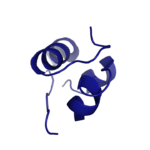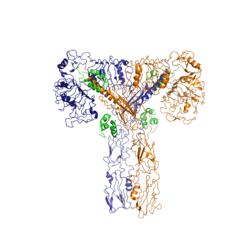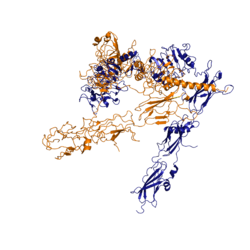Johnson's Monday Lab Sandbox for Insulin Receptor
From Proteopedia
(Difference between revisions)
| Line 5: | Line 5: | ||
==Function of the Receptor== | ==Function of the Receptor== | ||
| - | The insulin receptor resides within the [http://en.wikipedia.org/wiki/Cell_membrane plasma membrane] of insulin target cells of different organs, such as the liver, and tissues including skeletal muscle and adipose. Activation of the insulin receptor is dependent upon insulin binding. Once activated, the receptor serves as the gateway for the regulation of various cellular processes. These processes include but are not limited to glucose transport, glycogen storage, [http://en.wikipedia.org/wiki/Autophagy autophagy], [http://en.wikipedia.org/wiki/Apoptosis apoptosis], and gene expression. Additionally, the insulin receptor has been associated with the development of diseases such as Alzheimer's, Type II Diabetes, and cancer <ref name="Scapin" />. Characterization of the structure of the insulin receptor as well as understanding of the molecular mechanisms which initiate a conformational change are important for understanding the role that the insulin receptor plays within a cell and in the development of disease. | + | The insulin receptor resides within the [http://en.wikipedia.org/wiki/Cell_membrane plasma membrane] of insulin target cells of different organs, such as the liver, and tissues including skeletal muscle and adipose. Activation of the insulin receptor is dependent upon insulin binding. Once activated, the receptor serves as the gateway for the regulation of various cellular processes. These processes include but are not limited to glucose transport, glycogen storage, [http://en.wikipedia.org/wiki/Autophagy autophagy], [http://en.wikipedia.org/wiki/Apoptosis apoptosis], and gene expression. Additionally, the insulin receptor has been associated with the development of diseases such as Alzheimer's, Type II Diabetes, and cancer <ref name="Scapin" />. Characterization of the structure of the insulin receptor, as well as understanding of the molecular mechanisms which initiate a conformational change, are important for understanding the role that the insulin receptor plays within a cell and in the development of the disease. |
==Insulin== | ==Insulin== | ||
| - | [[Image:Insulin.png|thumb|right|150px|Figure 1: Insulin molecule]] Insulin is a [http://en.wikipedia.org/wiki/Hormone hormone] that is synthesized and secreted from the pancreas in response to high concentrations of glucose in the blood. Once it is secreted, it will move through the | + | [[Image:Insulin.png|thumb|right|150px|Figure 1: Insulin molecule]] Insulin is a [http://en.wikipedia.org/wiki/Hormone hormone] that is synthesized and secreted from the pancreas in response to high concentrations of glucose in the blood. Once it is secreted, it will move through the bloodstream and attach to an insulin receptor. Once multiple insulins are bound to the receptor, it is activated and as mentioned previously, the regulation of various cellular processes is initiated. |
==Structure== | ==Structure== | ||
| - | The insulin receptor is a [http://en.wikipedia.org/wiki/Receptor_tyrosine_kinase receptor tyrosine kinase]. It is a heterotetramer | + | The insulin receptor is a [http://en.wikipedia.org/wiki/Receptor_tyrosine_kinase receptor tyrosine kinase]. It is a heterotetramer that is constructed from two homodimers. Each homodimer maintains an extracellular domain, transmembrane helix, and an intracellular domain. The extracellular domain is divided into alpha and beta [https://en.wikipedia.org/wiki/Protein_subunit subunit]. The alpha subunit is characterized by two leucine-rich regions and one cysteine-rich region. The beta subunit contains three fibronectin type III domains. The alpha and beta subunits of the extracellular domains fold over one another and form a "V" shape when the insulin receptor is inactivated. Upon activation, the extracellular domain undergoes a conformational change and forms a "T" shape. |
[[Image:Insulin Receptor T.png|thumb|right|250px|Figure 2: Insulin receptor in the active "T" shape conformation with four insulins bound]] | [[Image:Insulin Receptor T.png|thumb|right|250px|Figure 2: Insulin receptor in the active "T" shape conformation with four insulins bound]] | ||
| - | An additional component to the ectodomain is the ''alpha'' chain C-terminal helix <ref name= "Uchikawa" />. The ''alpha''-CT is a single alpha helix and it plays an important role in insulin binding and stabilization of the "T" shape activated conformation. The ''alpha''-CT interacts with a leucine rich region of the alpha subunit and a fibronectin type III region of the beta subunit to form an insulin binding site <ref name="Uchikawa" />. | + | An additional component to the ectodomain is the ''alpha'' chain C-terminal helix <ref name= "Uchikawa" />. The ''alpha''-CT is a single alpha-helix and it plays an important role in insulin binding and stabilization of the "T" shape activated conformation. The ''alpha''-CT interacts with a leucine-rich region of the alpha subunit and a fibronectin type III region of the beta subunit to form an insulin binding site <ref name="Uchikawa" />. |
The structure of the extracellular domain is stabilized through [http://en.wikipedia.org/wiki/Covalent_bond covalent bonds]. The alpha subunits are linked through two disulfide bonds. Cys468 and Cys524 of one alpha subunit are bound to Cys435 and Cys524 of the other alpha subunit, respectively <ref name="Schäffer" />. | The structure of the extracellular domain is stabilized through [http://en.wikipedia.org/wiki/Covalent_bond covalent bonds]. The alpha subunits are linked through two disulfide bonds. Cys468 and Cys524 of one alpha subunit are bound to Cys435 and Cys524 of the other alpha subunit, respectively <ref name="Schäffer" />. | ||
| Line 22: | Line 22: | ||
It was found that at least three insulin molecules would have to bind to the receptor for the receptor to take on its active “T-state” conformation <ref name="Uchikawa" />. The difference between the fully bound state with four insulins and the three insulin bound state is minimal compared to the difference between two and three insulins bound <ref name="Uchikawa" />. | It was found that at least three insulin molecules would have to bind to the receptor for the receptor to take on its active “T-state” conformation <ref name="Uchikawa" />. The difference between the fully bound state with four insulins and the three insulin bound state is minimal compared to the difference between two and three insulins bound <ref name="Uchikawa" />. | ||
| - | The insulin molecules in site 1 and 1' have their main interactions with an <scene name='83/839263/Insulin_bound_to_site_1/2'>alpha helix</scene> in the insulin receptor. The insulin molecules are shown in green and the insulin receptor is shown in orange. The insulin molecules in site 2 and 2' have their main interactions with the residues that comprise some of the <scene name='83/839263/Insulin_in_site_2_with_beta_sh/3'>beta-sheets</scene> of the insulin receptor. The red molecules are insulin and the yellow is the beta sheets of the insulin receptor. | + | The insulin molecules in site 1 and 1' have their main interactions with an <scene name='83/839263/Insulin_bound_to_site_1/2'>alpha helix</scene> in the insulin receptor. The insulin molecules are shown in green and the insulin receptor is shown in orange. The insulin molecules in site 2 and 2' have their main interactions with the residues that comprise some of the <scene name='83/839263/Insulin_in_site_2_with_beta_sh/3'>beta-sheets</scene> of the insulin receptor. The red molecules are insulin and the yellow is the beta-sheets of the insulin receptor. |
===Conformational Changes=== | ===Conformational Changes=== | ||
| Line 28: | Line 28: | ||
The conformational change between the inverted "V" shape and the "T" shape of the insulin receptor is induced by insulin binding. When an insulin molecule binds to site 1 of the alpha subunit, the respective protomer is recruited and a slight inward movement of the fibronectin type III domains of the beta subunit is initiated. Binding of insulin to both protomers establishes a full activation of the insulin receptor. This activation is demonstrated through the inward movement of both protomers. This motion has been referred to as a "hinge" motion <ref name="Uchikawa" /> as both protomers "swing" in towards one another. | The conformational change between the inverted "V" shape and the "T" shape of the insulin receptor is induced by insulin binding. When an insulin molecule binds to site 1 of the alpha subunit, the respective protomer is recruited and a slight inward movement of the fibronectin type III domains of the beta subunit is initiated. Binding of insulin to both protomers establishes a full activation of the insulin receptor. This activation is demonstrated through the inward movement of both protomers. This motion has been referred to as a "hinge" motion <ref name="Uchikawa" /> as both protomers "swing" in towards one another. | ||
| - | As the fibronectin type III domains of the beta subunit swing inward, the alpha subunits also undergo a conformational change upon insulin binding. As insulin binds to site 1, the leucine rich region of one protomer interacts with the ''alpha''-CT and the FNIII-1 domains of the other protomer to form a binding site. These interactions are referred to as a tripartite interface <ref name="Uchikawa" />. In order for the tripartite interface to form, the alpha subunits of each protomer must undergo a "folding" motion. | + | As the fibronectin type III domains of the beta subunit swing inward, the alpha subunits also undergo a conformational change upon insulin binding. As insulin binds to site 1, the leucine-rich region of one protomer interacts with the ''alpha''-CT and the FNIII-1 domains of the other protomer to form a binding site. These interactions are referred to as a tripartite interface <ref name="Uchikawa" />. In order for the tripartite interface to form, the alpha subunits of each protomer must undergo a "folding" motion. |
While there is an explanation for which conformational changes of the insulin receptor take place, there is no explanation for the mechanism by which the conformational changes are executed <ref name="Uchikawa" />. | While there is an explanation for which conformational changes of the insulin receptor take place, there is no explanation for the mechanism by which the conformational changes are executed <ref name="Uchikawa" />. | ||
Revision as of 14:59, 26 March 2020
Insulin Receptor
| |||||||||||



